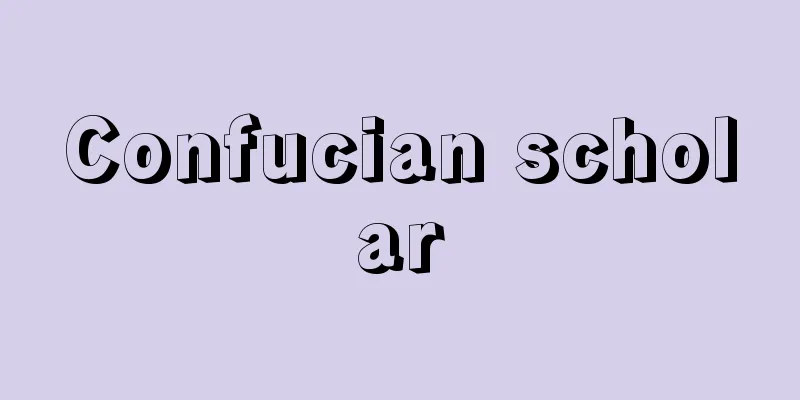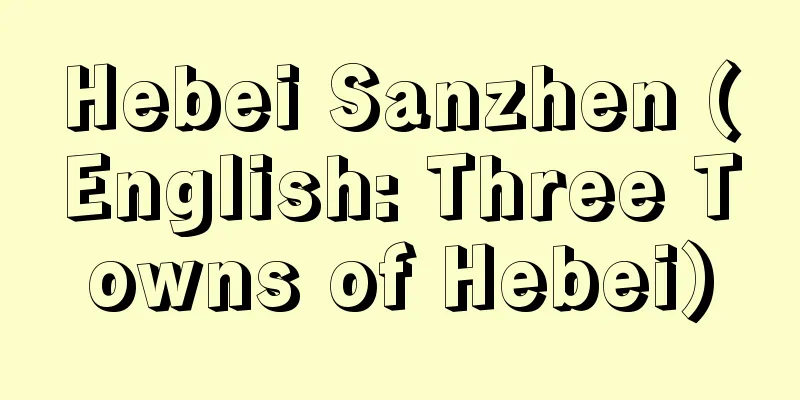Confucian scholar

|
A person who studies and teaches Confucianism, especially its scriptures. In ancient and medieval Japan, doctors such as the Kiyohara and Nakahara clans who lectured on Myogyo-do could be called Confucian scholars. However, at that time, the scriptures were studied as part of Chinese classics by Buddhist monks, doctors, priests, and other people in various professions and ranks, and did not fully develop into a unique field of expertise. Therefore, the term Confucian scholar is not often found before the early modern period. However, from the end of the Warring States period to the Edo period, the demand for Confucianism in politics, ethics, academics, etc. increased, and the import, production, and distribution of Chinese and Korean Chinese texts expanded. Many experts who interpreted and preached Confucian classics began to appear, and these people came to be called Confucian scholars. The "ojusha" (official Confucian scholars) who served the shogun or daimyo and received a salary or stipend began with Hayashi Razan being employed by the shogunate, and gradually spread to each domain. In addition, the number of "town Confucian scholars" such as Nakae Toju and Ito Jinsai, who ran private schools or medical practices, also increased among the general public. However, in Japan, unlike in China and Korea, where the imperial examinations and religious ceremonies were established and landlords and rulers were given the lead in Confucianism, Confucian scholars were on the periphery of politics and had weak livelihoods. However, as Chinese scholars, they had a strong tendency to freely choose their scriptures, and from there they moved on to other texts, and the shift to the various studies that would later be called Japanese studies, Dutch studies, and military science spread. [Makoto Kurozumi] "Watanabe Hiroshi, 'Confucian Scholars, Readers, Yangban: The Existence of Confucian 'Educated People'" (included in 'East Asian Kingship and Thought', 1997, University of Tokyo Press)" "Kurozumi Makoto, 'Confucianism and Early Modern Japanese Society' (included in 'Early Modern Japanese Society and Confucianism', 2003, Pelican Press)" Source: Shogakukan Encyclopedia Nipponica About Encyclopedia Nipponica Information | Legend |
|
儒教とくにその経典を学びまた教える者のこと。日本の古代・中世では、明経道(みょうぎょうどう)を講学した清原氏・中原氏などの博士が儒者といえる。ただ、その際、経典は漢籍の一環として、仏僧、博士、神官など各職域・身分において学ばれ、独自の専門領域は十分に成り立ってはいなかった。そのため近世以前には、儒者の語はあまり見出せない。ただ、戦国末から江戸期になると、政治・倫理・学術など儒学の需要が高まり、中国や朝鮮の漢字文献の輸入とその生産・流通が拡大する。儒学の典籍を読み解き唱導する専門家も多く現れ始め、これが儒者と呼ばれるようになった。将軍・大名などに仕えて給与としての禄や扶持を受け取る「御儒者(おじゅしゃ)」は、林羅山(らざん)が幕府に雇用されたことに始まり、しだいに各藩に広がった。また民間でも、中江藤樹(とうじゅ)・伊藤仁斎(じんさい)など学塾や医業などを営む「町儒者(まちじゅしゃ)」が増加していった。しかし日本では、中国・朝鮮などのように科挙・祭祀が確立され地主・為政者として儒学を率先する担い手となる体制は成立せず、儒者は政治周辺の存在となり生活基盤も弱かった。とはいえ、漢学者として経典を自由に選択する傾向も強く、そこから他のテキストに向かい、のちに国学・蘭学・兵学と称される諸学への転換も拡大した。 [黒住 真] 『渡辺浩著「儒者・読書人・両班―儒学的『教養人』の存在形態」(『東アジアの王権と思想』所収・1997・東京大学出版会)』▽『黒住真著「儒学と近世日本社会」(『近世日本社会と儒教』所収・2003・ぺりかん社)』 出典 小学館 日本大百科全書(ニッポニカ)日本大百科全書(ニッポニカ)について 情報 | 凡例 |
Recommend
Chair - Chair
The English word "chair" refers to a sea...
Fujima-ryu
A school of Japanese dance. The founder of the sc...
Shoulder removal (Kabuki) - katanugi
...Kabuki, along with Bugaku, Noh, Kyogen, and Bu...
Hartley, R. von L.
...The history of telecommunications has already ...
Jingikan - Jingikan
(1) One of the government offices under the ritsu...
Akana Pass - Akana Pass
A pass that forms a watershed on the border betwe...
Masuhiro Ozeki
1838 * - 1868 * A daimyo from the end of the Edo ...
Peaceful coexistence
A theory, movement, and policy that advocates a s...
Alamūt (English spelling)
An Assassin fortress built on a steep rocky mounta...
incombustible moss
…The scientific name antipyretica , which means “...
Pentastomida
…They live parasitically inside the bodies of rep...
Snow Bug - Yukimushi
〘Noun〙① (The name comes from the fact that the whi...
Kidama-sama - Kidama-sama
...Today, kodama are considered to be yamabiko, w...
Yuan Hongdao
A Chinese poet from the late Ming Dynasty. His pe...
Kiloelectronvolt - Kiloelectronvolt
...The charge of an electron is approximately 1.6...









